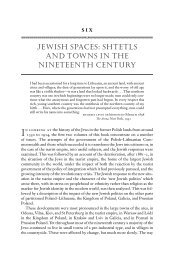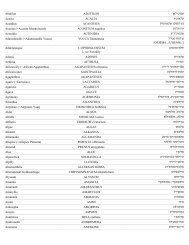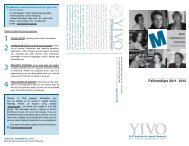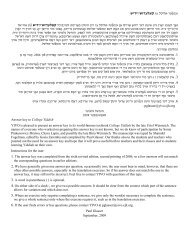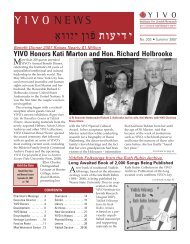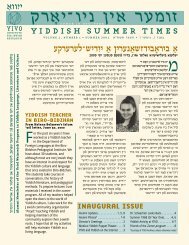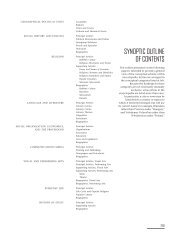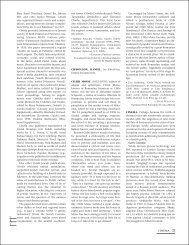t any plant names in Yiddish - YIVO Institute for Jewish Research
t any plant names in Yiddish - YIVO Institute for Jewish Research
t any plant names in Yiddish - YIVO Institute for Jewish Research
You also want an ePaper? Increase the reach of your titles
YUMPU automatically turns print PDFs into web optimized ePapers that Google loves.
XXXII<br />
Written vs. spoken <strong>Yiddish</strong><br />
˘È„”È Ôȇ ËÏÚÂÂ≠ÔÒ˜ÈÂÂÚ‚ È„ Ÿ ¯ÚËÎÚ˘ È΄¯Ó<br />
M<strong>any</strong> botanical terms that we encounter <strong>in</strong> FLY have obvious MHG<br />
(or Early NHG) cognates, but there is no certa<strong>in</strong>ty that a given word encountered<br />
<strong>in</strong> a text was actually used <strong>in</strong> the spoken WY of the time. Thus<br />
the series ‡Ùȇ ¨ÍÈÙȇ ¨ÍÂÙȇ possibly, but not necessarily, reflects spoken<br />
WY, with ‡Ùȇ the <strong>for</strong>m used by the bney-hes, those WY-speakers with<br />
zero articulation of /x/. The NHG correspondent is Eppich.<br />
In a number of cases, we can safely assume that the attested FLY<br />
<strong>for</strong>m corresponded to the spoken WY one. One example: the term <strong>for</strong> apple.<br />
In MLY, it is epl, <strong>in</strong> both s<strong>in</strong>gular and plural, and likewise <strong>in</strong> most of<br />
EY. Some areas of Central <strong>Yiddish</strong>, however, still preserve an archaic s<strong>in</strong>gular<br />
<strong>for</strong>m apl (and a variant /ápu/), thus confirm<strong>in</strong>g the <strong>for</strong>m apl, if not<br />
apf(i)l, amply attested <strong>in</strong> FLY. There is also no doubt that nus, nusn/nis,<br />
and others were present <strong>in</strong> spoken WY, not just FLY, s<strong>in</strong>ce they rema<strong>in</strong><br />
common <strong>in</strong> Eastern Europe <strong>in</strong> modern times.<br />
With regard to lexical items of Semitic derivation, it is also sometimes<br />
doubtful from FLY evidence whether the recorded items were actually part<br />
of spoken WY. A case <strong>in</strong> po<strong>in</strong>t as an obviously unreliable source <strong>for</strong> <strong>Yiddish</strong><br />
botanical term<strong>in</strong>ology is Callenberg (1733). He does not seem to be<br />
able to dist<strong>in</strong>guish between Hebrew and <strong>Yiddish</strong> and lists the Hebrew<br />
terms <strong>for</strong> apple, wheat, barley, rye, onions, almond, etc., as <strong>Yiddish</strong>! Unless<br />
some of them were part-and-parcel of spoken WY without modern<br />
<strong>Yiddish</strong> l<strong>in</strong>guistics be<strong>in</strong>g aware of it.<br />
On the other hand, just as <strong>in</strong> other lexical fields, we must observe that<br />
while some items of Semitic derivation were characteristic <strong>for</strong> WY and FLY,<br />
others are characteristic <strong>for</strong> EY and MLY. Thus, sháyne-boym, (resh-)khóydeshrétekhl,<br />
et al. are attested only <strong>in</strong> EY and/or MLY.<br />
A clearcut difference between 'East' and 'West' – WY and EY, FLY<br />
and MLY – is the role botanical terms of Slavic orig<strong>in</strong> play: while <strong>in</strong> WY<br />
kreyn 'horseradish' (EY: khreyn) 20 is attested from the 14th century on –<br />
along with meretish (cf. NHG Meerretich) – and yag(e)des (Or Khodesh<br />
1671:27)/yades (Preger 1650: 5) 'berries' from the 17th century on – the<br />
bulk of Slavic-orig<strong>in</strong> botanical terms entered the <strong>Yiddish</strong> language <strong>in</strong> its<br />
EY/MLY phase. Thus the parallel series (the first word – WY of Germanic<br />
orig<strong>in</strong>, the second – EY of Slavic, Semitic, or other derivation): líndebam<br />
vs. lipe 'l<strong>in</strong>den'; éykhebam vs. demb (plus variants) 'oak'; véydebam vs. vérbe<br />
'willow' (and sháyne-boym); péterzil/péterzayl vs. pétreshke 'parsley'; loukh vs.<br />
póre-tsíbele (or prazh) 'leek'; ámper vs. shtshav 'sorrel', and so on.<br />
All <strong>in</strong> all, <strong>Yiddish</strong> botanical term<strong>in</strong>ology is a fertile ground <strong>for</strong> l<strong>in</strong>guistic<br />
research from both a synchronic and diachronic po<strong>in</strong>t of view.<br />
20) It rema<strong>in</strong>s an open question whether WY derived this word directly from Czech/Western<br />
Canaanic or through the mediation of German dialects (M. We<strong>in</strong>reich 1973: II: 199 ff.).



